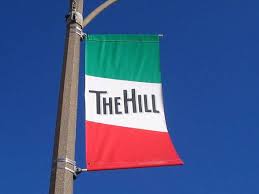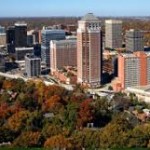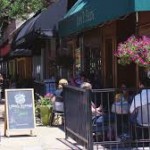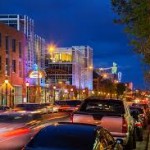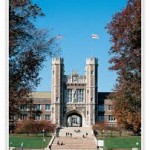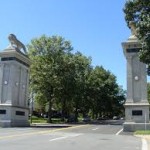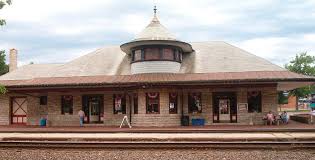St. Louis City – A City Made Up of Neighborhoods
The city is divided into 79 neighborhoods. The divisions have no legal standing, although some neighborhood associations administer grants or hold veto power over historic-district development. Nevertheless, the social and political influence of neighborhood identity is profound. Some hold avenues of massive stone edifices built as palaces for heads of state visiting the 1904 World’s Fair. Others offer tidy working-class bungalows, loft districts, or areas hard-hit by social problems and unemployment. Many of them have retained – quite consciously and deliberately – a camaraderie missing from many American towns today.
St. Louis also possesses several distinct examples of 18th and 19th century architecture, such as the Soulard Market district (1779-1842), the Chatillon-de Menil House (1848), the Bellefontaine Cemetery (1850), the Robert G. Campbell House (1852), the Old Courthouse (1845-62), the original Anheuser-Busch Brewery (1860), and two of Louis Sullivan’s early skyscrapers, the Wainwright Building (1890-91) and the Union Trust Building. 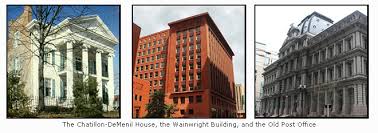
Among the best-known, architecturally significant, or well-visited neighborhoods are, Central West End, The Hill, Lafayette Square, Clayton/Tamm (Dogtown), Tower Grove, Shaw (home to the Missouri Botanical Garden and named after the Garden’s founder, Henry Shaw), Soulard (home of the second-largest Mardi Gras festival in the nation), Benton Park, Forest Park Southeast (The Grove), Carondelet, Dutchtown South, Grand Center, Southwest Garden, Hortense Place (home to many grand mansions) and Wydown/Skinker.
Central West End is one of St. Louis’ many historic neighborhoods developed around the turn of the century following the dedication of nearby Forest Park- a sprawling urban park that is home to our zoo, art and history museums and much more. Development continued as St. Louis prepared for its 1904 Worlds Fair and many of the city’s wealthier citizens gravitated to the area to build stunning single-family homes. Opulent and grand in scale the Central West End is home to some of St. Louis’ most historic residences. These homes were the epitome of elegance, one having so much marble detailing that it took workmen two full years to install it. 
The Hill is a historically Italian neighborhood where many of the area’s best Italian restaurants can be found. The Hill was the home of Yogi Berra and many other noted baseball players. It’s also said to be where toasted ravioli was invented, a St. Louis appetizer staple-if you haven’t tried it, you’re missing out! In the 1800’s, Italian immigrants worked the area’s clay mines, and built small bungalows to house their families. Today, the area retains row upon row of almost-touching bungalows up and down the streets, virtually defining the neighborhood known as The Hill.
Dogtown, is the unofficial name of the area called Forest Park Southwest. There are several stories about the origin of the name, the favorite being that dog-eating Igorot tribesmen on display at the 1904 World’s Fair did their hunting there.
Soulard, with its brick row houses and ornate wrought iron, is a little bit of old Europe in the near south side. The Soulard Farmer’s Market features an eclectic array of food—from freshly caught channel catfish to exotic spices and decorative vegetables. Low prices attract gourmet and fixed-income shoppers alike, and on any given Saturday, up to 20 different languages can be heard as customers wind their way through rows of stands.
Want to know more about the City of Saint Louis?
Check their website.
St. Louis County – Small Towns with Urban Benefits
St. Louis County, which surrounds St. Louis City, is made up of 91 townships — individual municipalities with separate fire departments, police stations, city halls, recreation centers, and more. Each boasts a small piece of St. Louis history, its residents fierce in their dedication to the unique style, location and ambience of their own town.
These towns offer a wonderful neighborhood feel, complimenting the urbanity of St. Louis City and minimizing the otherwise overwhelming impact of a 2.5 million total metropolitan population. With area schools, shopping, entertainment, restaurants, and sports at their fingertips, many residents rarely step outside their own neighborhood.
St. Louis County is divided and identified by its Interstate highways. North County is the area north of Interstate 70. West County, lies between I-70 and I-44. Everything south of I-44 is South County. These are general definitions, usually agreed upon by St. Louisans. The popular Central Corridor, runs along Hwy. 40 from Clayton to Chesterfield through West County.
Clayton, is the St. Louis County seat, and boasts what some call a second Downtown, made up of government buildings and corporate headquarters just west of Forest Park. Residences date back to the early 20th century, with large, sweeping lawns, red tile roofs and circular driveways surrounded by lush greenery.
University City, is home to nationally acclaimed Washington University, and boasts a vibrant shopping and entertainment area called The Loop. The area is popular with academics, students, and bohemians of all ages, with its delightful hodge-podge of original and rehabbed housing within walking distance of outdoor cafes, eclectic shops, bookstores, movie theatres and more.
Kirkwood, dates back to the turn of the century, when it was established as the turn-around point for St. Louis City’s trolley system. Kirkwood features old Victorian homes built to house the city’s wealthy families during the sweltering summer months. Today, Kirkwood takes great pride in its place in St. Louis history, with its beautiful old homes, the original, still functioning train station and a wonderful outdoor farmer’s market.
Creve Coeur, is a reminder of St. Louis’ early French beginnings. Translated, Creve Coeur means Broken Heart. A variety of stories feature a Native American princess in the area of Creve Coeur Lake. Today, Creve Coeur is a thriving township with shopping, office centers, executive parkways, and housing ranging from single-family homes to luxury condominiums to popular apartment communities.



